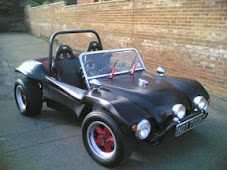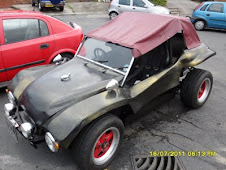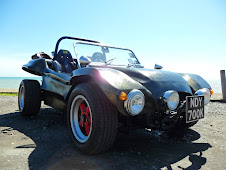 I Finally had enough time to get the welding gear outside and the house. The weather being the hardest thing was great and I bought the buggy down to the house with both impact bars bolted in there respective positions ready for welding.
I Finally had enough time to get the welding gear outside and the house. The weather being the hardest thing was great and I bought the buggy down to the house with both impact bars bolted in there respective positions ready for welding.Unfortunately my generator was not capable of delivering peak voltages that the welder needed so I could not do this work in the garage as it has no constant power supply.
The piece that I needed to weld was sitting on top of the body works fiberglass perimeter and I was unsure weather welding or tacking the pieces would cause the fiberglass to burn. I ran a bucket of water and placed a cloth in it just in case. The cloth would also be useful to quench the metal should they get too hot.
I started with the passenger side as I would not have to navigate past the steering column on the first weld and hoped I could gain experience, that would help me on the other side. I placed the two pieces of plumbing matting that I had found on the wall of the body to shield it from the heat. I managed to tack the two pieces together fairly easily. The join seemed fairly good as I was able to unbolt and remove the two pieces which where now one. Once I had removed the part I was able to weld the two items securely all the way round. I remembered my father telling me that you test a good weld by tapping the different parts of the same object and listen to the ring it gives out. The tone should be the same wherever you tap, indicating the item is one solid piece.
The driver side was much the same although the restricted access made the taking process a little difficult. I managed to remove the joined pieces and again successfully welded them.
Once the pieces had cooled. I bolted them back in and cleared up wanting to take the car out for a run to see if it had made and difference to the cars handling.
Straight away the buggy seemed stiffer and seemed to handle more positively on the road. I was surprised that this had improved the handling and am now wondering what else I can find that will improve the cars handling still further. bearing mind I was planning to fit a turbo + injection system to the car any increase in the cars handling on the road would be beneficial.
I am planning to get the new bars zinc plated , but I will have to contact my metal plater to see how much this will cost and when it can be done.
All in all, my side impact bars seemed to be a success.


























